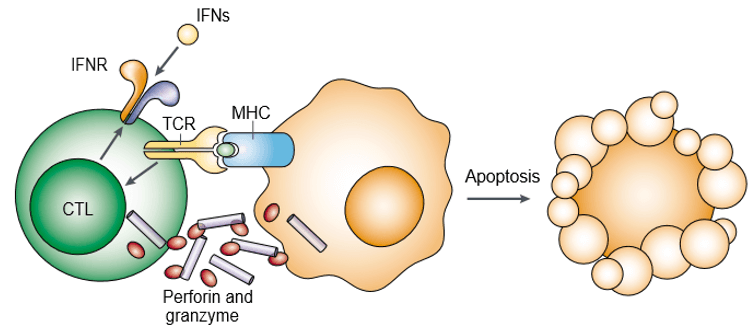views

Perforin/granzyme apoptosis pathway is the primary signaling pathway used by cytotoxic lymphocytes to eliminate virus-infected and/or transformed cells. Studies in gene-disrupted mice indicate that perforin, in combination with granzyme, could induce apoptosis. It is vital for cytotoxic effector function and has an indispensable, but an undefined role in granzyme-mediated apoptosis.
Perforin and Granzyme
Perforin is a pore-forming protein and also known as cytoplasmic granule toxins. Granzyme is a family of structurally related serine proteases stored within the cytotoxic granules of cytotoxic lymphocytes (CLs). Perforin and granzyme induce target-cell apoptosis cooperatively (Figure 1). Granzyme is necessary for triggering apoptosis of target cells, but they depend on being appropriately delivered by perforin. Both perforin and granzyme bind to the target-cell surface as part of a single macromolecular complex associated with serglycin, which further diminishes the probability of passive diffusion of granzymes.

Figure 1. Perforin and granzyme induce target-cell apoptosis cooperatively.
In humans, there are granzyme A, B, H, K, and M, while in mice there are granzyme A, B, C, D, E, F, G, K, L, M, and N. Granzyme A (GrA) and granzyme B (GrB) are the most abundant granzymes and have been the most studied. The functions of granzymes A and B in inducing target-cell apoptosis have been investigated extensively in vitro, and they are better understood than the role of perforin at the molecular level.
Process and Regulation of Perforin/Granzyme Apoptosis Pathway
Once secreted by cytotoxic lymphocytes, granzymes enter into target cells, which is a vital step in cell death. The major lytic proteins packaged within the granules are different granzymes and the pore-forming protein perforin, which facilitates the internalization of granzymes by cells.
Granzyme B mainly triggers caspase activation indirectly, rather than by direct caspase processing. It achieves this by directly activating pro-apoptotic ‘BH3-only' members of the BCL-2 family, such as BH3-interacting domain death agonist (Bid). Bid together with pro-apoptotic BCL-2 family Bax and/or Bak proteins result in the leakage of pro-apoptotic mitochondrial mediators, such as cytochrome c, into the cytosol. Cytochrome c release activates pro caspase-9, and by binding to apoptotic protease activating factor 1(Apaf-1), pro caspase-9 becomes mature caspase-9, which continues to form the apoptosome and activates downstream caspase-3. Activated caspase-3 is able to cleave specific substrates like ICAD (inhibitor of the caspase-activated DNase, CAD), allowing the CAD to translocate to the nucleus to fragment DNA. Besides Bid, granzyme B can inactivate Mcl-1 which is a member of the anti-apoptotic Bcl-2 family to release the pro-anti-apoptotic Bcl-2 family protein Bim on the outer mitochondrial membrane. And granzyme B can also mediate the effector caspase-3 and initiator caspase-8 to regulate the apoptosis pathway.
Contrast to granzyme B, granzyme M doesn't dependent on mitochondrial to regulate, but granzyme M may activate granzyme B by the cleavage of proteinase inhibitor 9 (PI-9) which is the granzyme B inhibitor. Granzyme M also can directly cleave the ICAD to unleash CAD like granzyme B.
Granzyme A induces loss of mitochondrial inner membrane potential and the release of reactive oxygen species (ROS). It generates single-stranded DNA nicks, rather than oligonucleosomal DNA fragments. In response to ROS, the ER-associated SET complex, including SET, Ape1, pp32, HMG2, NM23-H1 and TREX1, translocates to the nucleus, where granzyme A cleaves three members of the SET complex that are involved in DNA repair: HMG2, Ape1, and SET.
Perforin/Granzyme Apoptosis Pathway in Disease
Studies in gene-disrupted mice indicate clearly that the perforin pathway is involved intimately in defense against viral pathogens and transformed cells. But, unsuspected roles for perforin as a crucial mediator of the immune surveillance of spontaneously transformed cells and in regulating B-cell homeostasis and T-cell memory have also been shown in vivo. Paradoxically, perforin is instrumental in the pathogenesis of certain autoimmune disease models, such as insulin-dependent diabetes in non-obese diabetic (NOD) mice, but it might suppress other autoimmune diseases, including experimental autoimmune encephalomyelitis (EAE).
The perforin and granzyme pathways that regulate granule polarization and exocytosis are being determined, and these pathways might be disrupted by the interaction of cancer cells with some cytotoxic lymphocytes. The recent findings that granzyme entering into target cells involves binding to specific membrane receptors and that some tumors synthesize serine protease inhibitors that can neutralize granzymes have indicated potential new ways in which tumors might escape immune attack.
References:
- Bots, M; Medema, J.P. Granzymes at a glance. Cell Science at a Glance. 2006, 119(Pt24): 5011-4.
- Boivin, W.A. Intracellular versus extracellular granzyme B in immunity and disease: challenging the dogma. Laboratory Investigation. 2009, 89(11): 1195-1220.





















Comments
0 comment